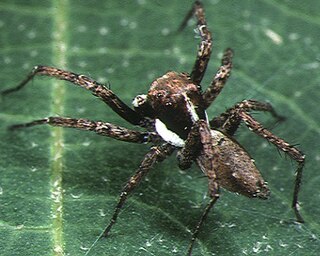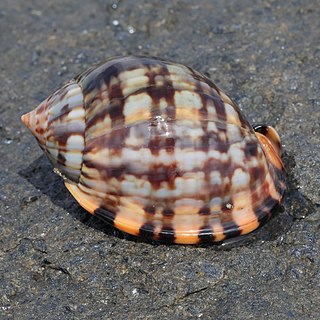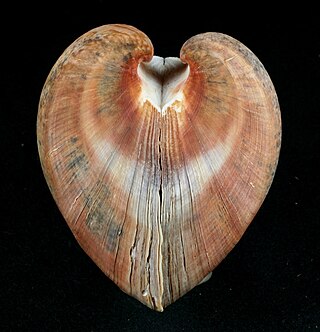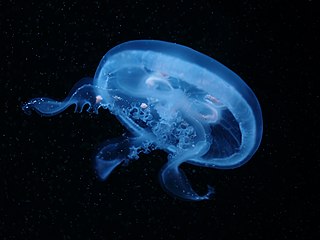
Convolvulaceae, commonly called the bindweeds or morning glories, is a family of about 60 genera and more than 1,650 species. These species are primarily herbaceous vines, but also include trees, shrubs and herbs. The tubers of several species are edible, the best known of which is the sweet potato.

Cattleya is a genus of orchids from Costa Rica south to Argentina. The genus is abbreviated C in trade journals.

Portia is a genus of jumping spider that feeds on other spiders. They are remarkable for their intelligent hunting behaviour, which suggests that they are capable of learning and problem solving, traits normally attributed to much larger animals.

The Ariidae or ariid catfish are a family of catfish that mainly live in marine waters with many freshwater and brackish water species. They are found worldwide in tropical to warm temperate zones. The family includes about 143 species.
Anguilla bengalensis labiata, the African mottled eel, is a subspecies of eel in the genus Anguilla of the family Anguillidae.

Portia labiata is a jumping spider found in Sri Lanka, India, southern China, Burma (Myanmar), Malaysia, Singapore, Java, Sumatra and the Philippines. In this medium-sized jumping spider, the front part is orange-brown and the back part is brownish. The conspicuous main eyes provide vision more acute than a cat's during the day and 10 times more acute than a dragonfly's, and this is essential in P. labiata′s navigation, hunting and mating.

Cattleya labiata, also known as the crimson cattleya or ruby-lipped cattleya, is the type species of Cattleya, discovered in 1818 in Brazil.

The mottled eel, also known as the African mottled eel, the Indian longfin eel, the Indian mottled eel, the long-finned eel or the river eel, is a demersal, catadromous eel in the family Anguillidae. It was described by John McClelland in 1844. It is a tropical, freshwater eel which is known from East Africa, Bangladesh, Andaman Islands, Mozambique, Malawi, Sri Lanka, Sumatra, and Indonesia and recently from Madagascar. The eels spend most of their lives in freshwater at a depth range of 3–10 metres, but migrate to the Indian Ocean to breed. Males can reach a maximum total length of 121 centimetres and a maximum weight of 7,000 grams. The eels feed primarily off of benthic crustaceans, mollusks, finfish and worms.

Semicassis labiata is a species of large predatory sea snail, a marine gastropod mollusc. This species is in the subfamily Cassinae, the "helmet shells" and "bonnet shells", which feed on sea urchins.

The false ark shells (Cucullaea) are a small genus of marine bivalve molluscs related to the ark clams. The genus is the only member of the family Cucullaeidae.
Triplophysa labiata, the Plain Thicklip Loach, is a species of ray-finned fish in the genus Triplophysa.

Aurelia labiata is a species of moon jellyfish. It is a cnidarian in the family Ulmaridae. It is typically larger than Aurelia aurita, with individuals document up to 45 cm (18 in). However, much of its size range overlaps with A. aurita, making size an imperfect diagnostic tool. Most Aurelia labiata have a 16-scalloped bell, meaning the bell indents inward at 16 points, a characteristic that also appears in other Aurelia species. Aurelia labiata occurs in the northeastern Pacific Ocean, from the northern coast of California, north to Canada and into Alaska.

Cucullaea labiata is a species of saltwater clam or ark shell, a marine bivalve mollusk in the family Cucullaeidae.

Crossea is a genus of very small sea snails or micromolluscs, marine gastropod molluscs in the family Conradiidae.

Emmesa is a genus of false darkling beetles in the family Melandryidae. There are about five described species in Emmesa.
Chinchaysuyoa labiata is a species of catfish in the family Ariidae. It was first described under the genus Arius as Arius labiatus in 1898. Another fish species, Hexanematichthys henni, was described by Homer Glenn Fisher and Carl H. Eigenmann in 1922 but is now considered to be a junior synonym for A. labiatus. A study in 2019 found that A. labiatus was distinct from any other catfish species in the region, and thus constructed the genus Chinchaysuyoa for it and the recently discovered species C. ortegai. It is endemic to freshwater bodies in Ecuador.
Chinchaysuyoa is a genus of catfishes in the family Ariidae. They are found in freshwater habitats along the Pacific Coast of northern South America. This genus was named after Chinchay Suyu, the Incan name for the region that these fishes are native to.
Chinchaysuyoa ortegai is a species of catfish in the family Ariidae. It is endemic to freshwater bodies in northern Peru. Specimens of this species were formerly classified as Hexanematichthys henni until they were found to actually represent a new species in the genus Chinchaysuyoa.
Cavolinia labiata is a species of pteropod in the family Cavoliniidae. It is a tropical species occurring in the Western Atlantic and Eastern Pacific Oceans. It can reach 0.7 cm (0.28 in) in length.











